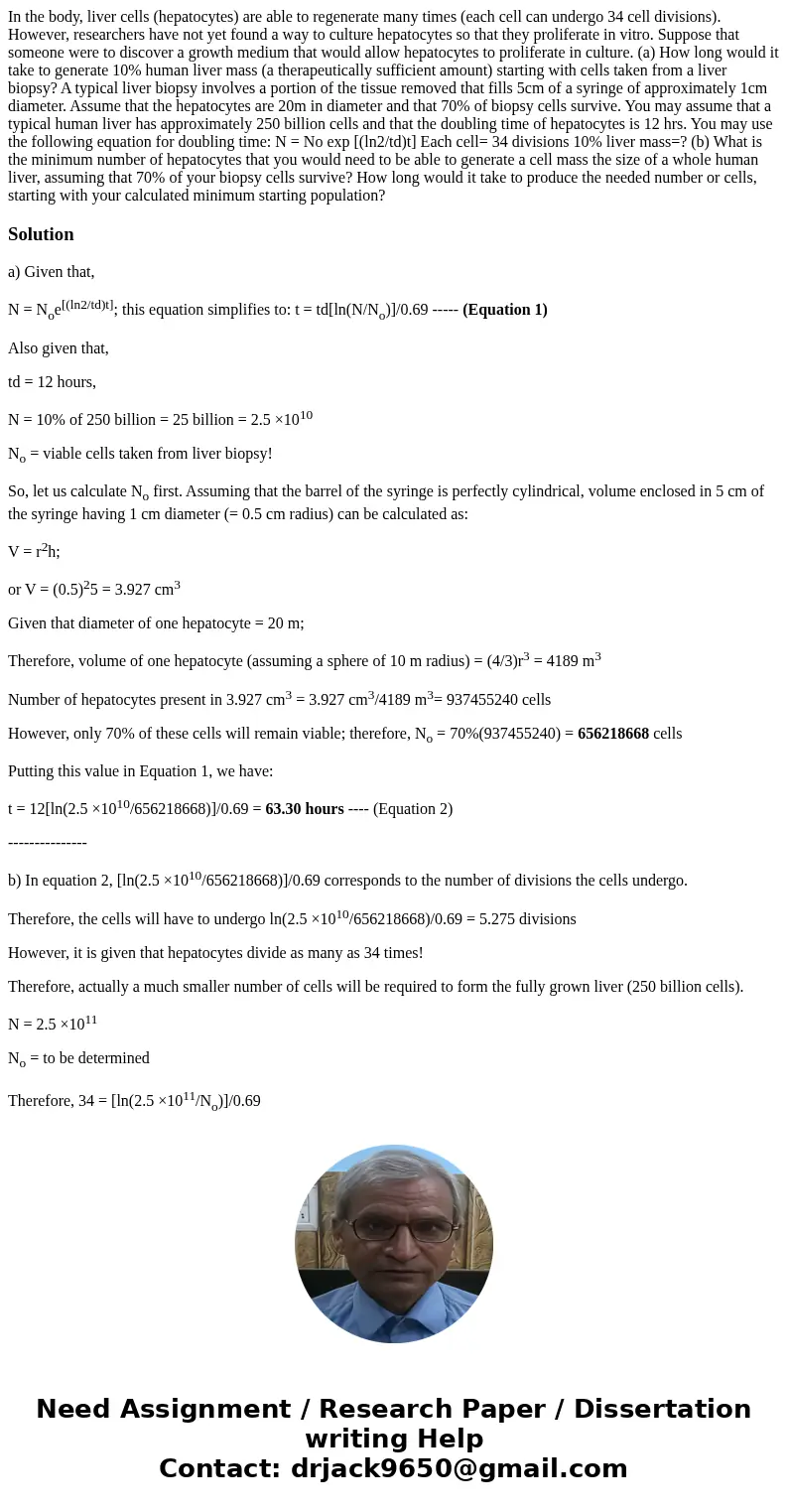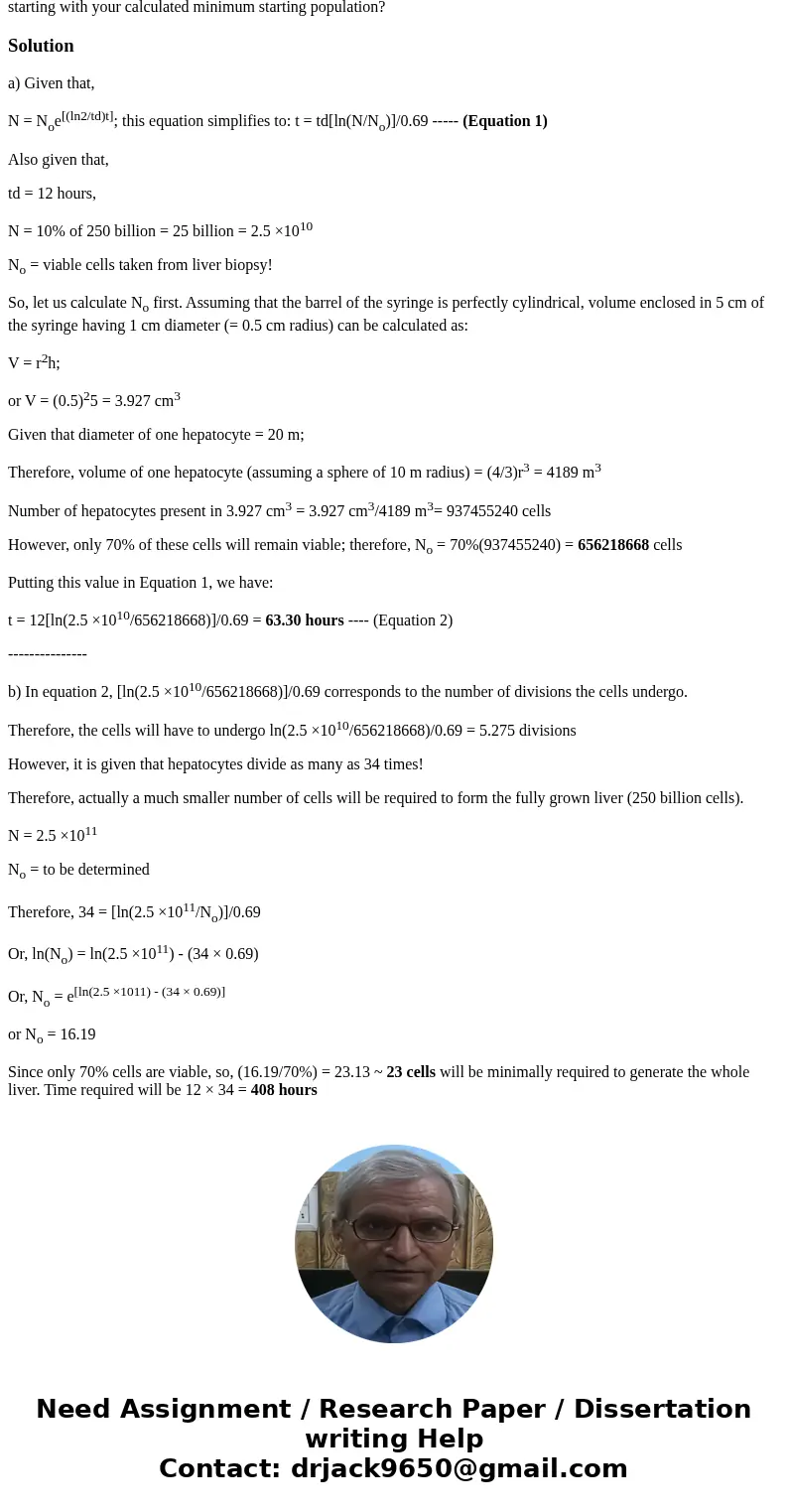In the body liver cells hepatocytes are able to regenerate m
In the body, liver cells (hepatocytes) are able to regenerate many times (each cell can undergo 34 cell divisions). However, researchers have not yet found a way to culture hepatocytes so that they proliferate in vitro. Suppose that someone were to discover a growth medium that would allow hepatocytes to proliferate in culture. (a) How long would it take to generate 10% human liver mass (a therapeutically sufficient amount) starting with cells taken from a liver biopsy? A typical liver biopsy involves a portion of the tissue removed that fills 5cm of a syringe of approximately 1cm diameter. Assume that the hepatocytes are 20m in diameter and that 70% of biopsy cells survive. You may assume that a typical human liver has approximately 250 billion cells and that the doubling time of hepatocytes is 12 hrs. You may use the following equation for doubling time: N = No exp [(ln2/td)t] Each cell= 34 divisions 10% liver mass=? (b) What is the minimum number of hepatocytes that you would need to be able to generate a cell mass the size of a whole human liver, assuming that 70% of your biopsy cells survive? How long would it take to produce the needed number or cells, starting with your calculated minimum starting population?
Solution
a) Given that,
N = Noe[(ln2/td)t]; this equation simplifies to: t = td[ln(N/No)]/0.69 ----- (Equation 1)
Also given that,
td = 12 hours,
N = 10% of 250 billion = 25 billion = 2.5 ×1010
No = viable cells taken from liver biopsy!
So, let us calculate No first. Assuming that the barrel of the syringe is perfectly cylindrical, volume enclosed in 5 cm of the syringe having 1 cm diameter (= 0.5 cm radius) can be calculated as:
V = r2h;
or V = (0.5)25 = 3.927 cm3
Given that diameter of one hepatocyte = 20 m;
Therefore, volume of one hepatocyte (assuming a sphere of 10 m radius) = (4/3)r3 = 4189 m3
Number of hepatocytes present in 3.927 cm3 = 3.927 cm3/4189 m3= 937455240 cells
However, only 70% of these cells will remain viable; therefore, No = 70%(937455240) = 656218668 cells
Putting this value in Equation 1, we have:
t = 12[ln(2.5 ×1010/656218668)]/0.69 = 63.30 hours ---- (Equation 2)
---------------
b) In equation 2, [ln(2.5 ×1010/656218668)]/0.69 corresponds to the number of divisions the cells undergo.
Therefore, the cells will have to undergo ln(2.5 ×1010/656218668)/0.69 = 5.275 divisions
However, it is given that hepatocytes divide as many as 34 times!
Therefore, actually a much smaller number of cells will be required to form the fully grown liver (250 billion cells).
N = 2.5 ×1011
No = to be determined
Therefore, 34 = [ln(2.5 ×1011/No)]/0.69
Or, ln(No) = ln(2.5 ×1011) - (34 × 0.69)
Or, No = e[ln(2.5 ×1011) - (34 × 0.69)]
or No = 16.19
Since only 70% cells are viable, so, (16.19/70%) = 23.13 ~ 23 cells will be minimally required to generate the whole liver. Time required will be 12 × 34 = 408 hours


 Homework Sourse
Homework Sourse